 W
WAcanthostichus hispaniolicus is an extinct species of ant in the subfamily Dorylinae known from a group of possibly Miocene fossils found on Hispaniola. A. hispaniolicus is the first species of the ant genus Acanthostichus to have been described from fossils found in Dominican amber and is the only species of Acanthostichus found in the West Indies.
 W
WAltirhinus is a genus of iguanodontian ornithopod dinosaur from the Early Cretaceous Period of Mongolia.
 W
WAustralerpeton is an extinct genus of stereospondylomorph temnospondyl currently believed to belong to the family Rhinesuchidae. When first named in 1998, the genus was placed within the new family Australerpetontidae. However, studies published a few years later questioned the systematics used in the original description and included the genus within Archegosauridae. A study by Dias & Schultz (2003) reassigned Australerpeton to the family Rhinesuchidae within the suborder Stereospondyli based on an earlier evaluation of the family. In this study, the close similarities between Australerpeton and archegosaurids were attributed to convergent evolution as a result of similar semi-aquatic lifestyles. A redescription of the skeleton of this genus was published by Eltink & Langer in 2014, and the skull was redescribed in a follow-up study published by Eltink et al. in 2016. These studies, as well as a 2017 study focusing on rhinesuchids in general, confirmed that Australerpeton was a rhinesuchid rather than an archegosaurid. Fossils of the genus have been found in the Rio do Rasto Formation of Brazil.
 W
WBatodonoides is a genus of extinct shrew-like mammals, which includes a species that is possibly the smallest mammal to have ever lived. Species of Batodonoides lived about 42 to 53 million years ago during the early to middle Eocene Epoch in North America. The genus contains four species: the type species B. powayensis, the older B. vanhouteni, B. walshi and B. rileyi.
 W
WBetelgeusia is an extinct genus of sea stars in the family Radiasteridae. It was described by Blake and Reid, in 1998, and existed in what is now the Netherlands, Texas, United States, Morocco, and India, during the Middle Jurassic through the Cretaceous period. It contains the species B. brezinai, B. exposita, B. reidi, and B. orientalis.
 W
WCamposaurus is a coelophysoid dinosaur genus from the Norian stage of the Late Triassic period of North America. The pertinent fossil remains date back to the early to middle Norian stage, and is widely regarded as the oldest known neotheropod.
 W
WCaudipteryx is a genus of peacock-sized theropod dinosaurs that lived in the Aptian age of the early Cretaceous Period. They were feathered and remarkably birdlike in their overall appearance. Two species have been described; C. zoui, in 1998, and C. dongi, in 2000.
 W
WCristatusaurus is a genus of theropod dinosaur that lived during the Early Cretaceous Period of what is now Niger, 112 million years ago. It was a baryonychine member of the Spinosauridae, a group of large bipedal carnivores with well-built forelimbs and elongated, crocodile-like skulls. The type species Cristatusaurus lapparenti was named in 1998 by scientists Philippe Taquet and Dale Russell, on the basis of jaw bones and some vertebrae. Two claw fossils were also later assigned to Cristatusaurus. The animal's generic name, which means "crested reptile", alludes to a sagittal crest on top of its snout; while the specific name is in honor of the French paleontologist Albert-Félix de Lapparent. Cristatusaurus is known from the Albian to Aptian Erlhaz Formation, where it would have coexisted with sauropod and iguanodontian dinosaurs, other theropods, and various crocodylomorphs.
 W
WDalinghosaurus is an extinct genus of lizards, first described in 1998 by S.A. Ji of the Peking University Department of Geology. The type species is Dalinghosaurus longidigitus.
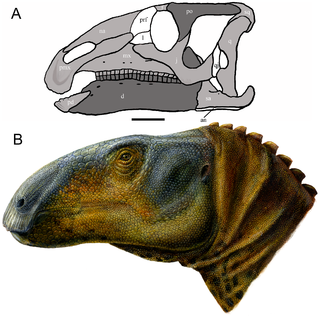 W
WEolambia is a genus of herbivorous hadrosauroid dinosaur from the early Late Cretaceous of the United States. It contains a single species, E. caroljonesa, named by paleontologist James Kirkland in 1998. The type specimen of Eolambia was discovered by Carole and Ramal Jones in 1993; the species name honors Carole. Since then, hundreds of bones have been discovered from both adults and juveniles, representing nearly every element of the skeleton. All of the specimens have thus far been found in Emery County, Utah, in a layer of rock known as the Mussentuchit Member of the Cedar Mountain Formation.
 W
WEucritta is an extinct genus of stem-tetrapod from the Viséan epoch in the Carboniferous period of Scotland. The name of the type and only species, E. melanolimnetes is a homage to the 1954 horror film Creature from the Black Lagoon.
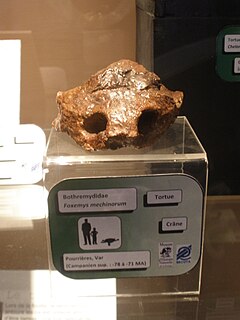 W
WFoxemys is an extinct genus of bothremydid turtle that was discovered at Fox Amphoux, France and also Hungary and Spain. Its skull and shell structure is similar to Polysternon. Two species are in the genus: F. mechinorum and F. trabanti.
 W
WGargoyleosaurus is one of the earliest ankylosaurs known from reasonably complete fossil remains. Its skull measures 29 centimetres (11 in) in length, and its total body length is an estimated 3 to 4 metres. It may have weighed as much as 1 tonne (2,200 lb). The holotype was discovered at the Bone Cabin Quarry West locality, in Albany County, Wyoming in exposures of the Upper Jurassic Morrison Formation.
 W
WGastonia is a genus of herbivorous ankylosaurian dinosaur from the Early Cretaceous of North America, around 139 to 125 million years ago. It is often considered a nodosaurid closely related to Polacanthus. Gastonia has a sacral shield and large shoulder spikes.
 W
WGeorgiacetus is an extinct genus of ancient whale known from the Eocene period of the United States. Fossils are known from Georgia, Alabama, and Mississippi and protocetid fossils from the right time frame, but not yet confirmed as Georgiacetus, have been found in Texas and South Carolina.
 W
WHondonadia is an extinct genus of Late Eocene to Early Oligocene (Tinguirirican) marsupials related to today's shrew opossums and with similar features as the related Rosendolops. The type species Hondonadia feruglioi was described by Goin and Candela in 1998. In later years, five more species were recognized, of which Pascualdelphys fierroensis, described by Flynn and Wyss in 1999, that was in 2010 synonymized with Hondonadia.
 W
WHuehuecuetzpalli mixtecus is an extinct lizard from the Early Cretaceous Tlayúa Formation in Tepexi de Rodríguez, Central Mexico. Although it is not the oldest known lizard, Huehuecuetzpalli may be the most basal member of Squamata, making it an important taxon in understanding the origins of squamates. It may or may not be a basal member of Iguania, a large clade of lizards that traditionally includes the iguanas and their close relatives, chameleons, and agamids: if it is an iguanian, H. mixtecus represents the earliest major offshoot of the squamate evolutionary tree.
 W
WIlokelesia is an extinct genus of abelisaurid theropod, preserved in the layers of the earliest Late Cretaceous of the Huincul Formation, Neuquén Group, located near Plaza Huincul, Neuquén Province, Argentina. The specimen, consisting of very fragmentary elements of the skull and the axial and appendicular skeleton, was described by Rodolfo Coria and Leonardo Salgado in late 1998.
 W
WJarilinus is an extinct genus of chroniosuchid reptiliomorph from upper Permian deposits of Novgorod and Orenburg Region, Russia. It was first named by V. K. Golubev in 1998, from skull fragments and trunk scutes. The type species is Jarilinus mirabilis.
 W
WKamagorgon is an extinct genus of therapsids from the Middle Permian of Russia. The type and only species is Kamagorgon ulanovi. It is only known from an incomplete skull. The snout is short and the canine teeth are very large. Kamagorgon was named in 1998 and originally classified in the biarmosuchian family Eotitanosuchidae along with the poorly known therapsid Eotitanosuchus. More recently, Kamagorgon has considered as a primitive gorgonopsian rather than a biarmosuchian due to the length of the front jawbone and rear side of the skull. These features are commonly shared by the brithopodid and biarmosuchid lineages.
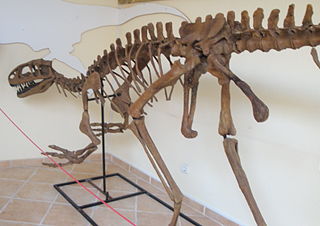 W
WLourinhanosaurus was a genus of carnivorous theropod dinosaur that lived during the Late Jurassic Period (Kimmeridgian/Tithonian) in Portugal. It is one of many large predators discovered at the Lourinhã Formation and probably competed with coeval Torvosaurus gurneyi, Allosaurus europaeus, and Ceratosaurus.
 W
WMegaraptor is a genus of large theropod dinosaur that lived in the Turonian to Coniacian ages of the Late Cretaceous. Its fossils have been discovered in the Patagonian Portezuelo Formation of Argentina. Initially thought to have been a giant dromaeosaur-like coelurosaur, it was classified as a neovenatorid allosauroid in previous phylogenies, but more recent phylogeny and discoveries of related megaraptoran genera has placed it as either a basal tyrannosauroid or a basal coelurosaur.
 W
WThe extinct Messelirrisor is a genus of Bucerotiformes, the sole representative of the family Messelirisoridae. They were tiny hoopoe-like birds that were the earliest representatives of the hoopoe/wood-hoopoe lineage, and they were among the predominant small forest birds of Central Europe during the Middle Eocene. Fossilized remains of Messelirrisor have been found in the Messel Pit of Hesse, Germany.
 W
WNedcolbertia is a genus of theropod dinosaur from the Early Cretaceous Period of North America.
 W
WOlenellus is an extinct genus of redlichiid trilobites, with species of average size. It lived during the Botomian and Toyonian stages (Olenellus-zone), 522 to 510 million years ago, in what is currently North-America, part of the palaeocontinent Laurentia.
 W
WPiscogavialis is an extinct genus of gryposuchine gavialid crocodylian. The only species yet known is P. jugaliperforatus. Fossils of Piscogavialis have been found from the Mio-Pliocene Pisco Formation of the Sacaco Basin in southern Peru in 1998. It is the first reptile known from the formation, which is otherwise notable for its high diversity of fossil vertebrates.
 W
WPluridens is an extinct genus of marine lizard belonging to the mosasaur family. Pluridens is classified within the Halisaurinae subfamily alongside the genera Phosphorosaurus, Eonatator and Halisaurus.
 W
WRahonavis is a genus of bird-like theropods from the Late Cretaceous of what is now northwestern Madagascar. It is known from a partial skeleton found by Catherine Forster and colleagues in Maevarano Formation rocks at a quarry near Berivotra, Mahajanga Province. Rahonavis was a small predator, at about 70 centimetres (2.3 ft) long and 0.45-2.27 kg, with the typical Velociraptor-like raised sickle claw on the second toe.
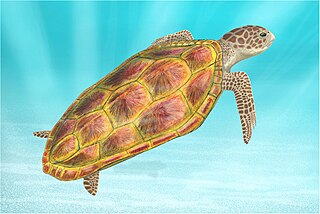 W
WSantanachelys gaffneyi is an extinct species of sea turtle. It is the only species in the genus Santanachelys, which itself is a member of the extinct family Protostegidae. The species was first described from a 20-centimeter long fossil specimen unearthed in 1998 from the Santana Formation of eastern Brazil. From the rock layer from which it was excavated, it was determined that the specimen was from the Early Cretaceous period. It is therefore one of the oldest known sea turtles. It was even recorded as the oldest sea turtle in Encyclopædia Britannica, but a new fossil named Desmatochelys padillai in 2015 is estimated to be as old as 120 million years.
 W
WScipionyx is a genus of compsognathid theropod dinosaur from the Early Cretaceous of Italy, around 113 million years ago.
 W
WSeorsumuscardinus is a genus of fossil dormice from the early Miocene of Europe. It is known from zone MN 4 in Oberdorf, Austria; Karydia, Greece; and Tägernaustrasse-Jona, Switzerland, and from zone MN 5 in a single site at Affalterbach, Germany. The MN 4 records are placed in the species S. alpinus and the sole MN 5 record is classified as the species S. bolligeri. The latter was placed in a separate genus, Heissigia, when it was first described in 2007, but it was reclassified as a second species of Seorsumuscardinus in 2009.
 W
WShuvuuia is a genus of bird-like theropod dinosaur from the late Cretaceous period of Mongolia. It is a member of the family Alvarezsauridae, small coelurosaurian dinosaurs which are characterized by short but powerful forelimbs specialized for digging. The type species is Shuvuuia deserti, or "desert bird". The name Shuvuuia is derived from the Mongolian word shuvuu (шувуу) meaning "bird".
 W
WSonorasaurus is a genus of brachiosaurid dinosaur from the Early to Late Cretaceous. It was a herbivorous sauropod whose fossils have been found in southern Arizona in the United States. Its name, which means "Sonora lizard", comes from the Sonoran Desert where its fossils were first found. The type species is S. thompsoni, described by Ratkevich in 1998.
 W
WSuchomimus is a genus of spinosaurid dinosaur that lived between 125 and 112 million years ago in what is now Niger, during the Aptian to early Albian stages of the Early Cretaceous period. The animal was named and described by palaeontologist Paul Sereno and colleagues in 1998, based on a partial skeleton from the Erlhaz Formation. Suchomimus's long and shallow skull, similar to that of a crocodile, earns it its generic name, while the specific name Suchomimus tenerensis alludes to the locality of its first remains, the Ténéré Desert.
 W
WTambachia is an extinct genus of dissorophoid temnospondyl within the family Trematopidae. It is known from the Early Permian Tambach Formation near the town of Tambach-Dietharz in Thuringia, Germany. Tambachia is the first trematopid to have been discovered outside the United States.
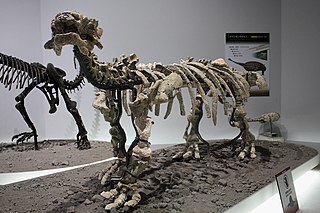 W
WTianzhenosaurus is a genus of ankylosaurid dinosaurs discovered in Tianzhen County, at Kangdailiang near Zhaojiagou Village, in Shanxi Province, China, in the Late Cretaceous Huiquanpu Formation. Thus far, a virtually complete skull and postcranial skeleton have been assigned to the genus, which is monotypic.
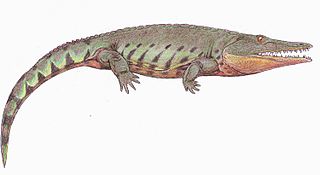 W
WUralerpeton is an extinct genus of chroniosuchid reptiliomorph from upper Permian deposits of Vladimir Region, European Russia. It was first named by V. K. Golubev in 1998, from skull fragments and trunk scutes. The type species is Uralerpeton tverdokhlebovae, it was a large predator with a 50 – 55 cm skull and a total length that probably exceeded 3 m (9.3 ft).
 W
WVariraptor is a genus of coelurosaurian theropod dinosaur from the Late Cretaceous of France.
 W
WZuniceratops was a ceratopsian dinosaur from the mid Turonian of the Late Cretaceous Period of what is now New Mexico, United States. It lived about 10 million years earlier than the more familiar horned Ceratopsidae and provides an important window on their ancestry.